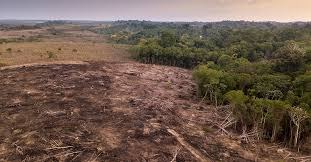
The Amazon rainforest, one of the planet’s most vital ecosystems, is undergoing an unprecedented rate of deforestation. The region, known as the "lungs of the Earth" for its role in absorbing carbon dioxide and producing oxygen, is under threat due to illegal logging, agriculture, and the ongoing impacts of climate change. In recent years, satellite data has revealed that deforestation rates in Brazil’s Amazon have reached levels not seen in decades, raising alarms globally about the environmental consequences.
Deforestation Drivers
The primary driver of deforestation in the Amazon is illegal logging, which accounts for a significant portion of forest loss. Large areas of rainforest are cleared to make way for cattle ranching, soy plantations, and other agricultural activities. The demand for land to produce crops and raise livestock is increasing, putting immense pressure on the forest’s natural resources. This is exacerbated by lax enforcement of environmental laws and weak penalties for illegal land-clearing practices.
Additionally, political factors have contributed to the crisis. Under the current Brazilian government, there has been a shift in policy that has made it easier for industries to exploit the Amazon’s resources. Environmental regulations have been loosened, and efforts to combat illegal logging and deforestation have been undermined. The government’s stance on development in the Amazon has been a controversial topic, with many environmental groups calling for stronger protections to preserve the rainforest.
Impacts on Biodiversity and Climate
The deforestation of the Amazon is having severe consequences for global biodiversity. The region is home to approximately 10% of the world’s known species, and the loss of forests threatens the habitats of countless plants and animals. Many of these species are yet to be studied and could hold the key to medical breakthroughs, making their loss not only a tragedy for nature but also for scientific advancement.
From a climate perspective, the deforestation of the Amazon has major implications. The forest acts as a carbon sink, absorbing large amounts of CO2 from the atmosphere. When trees are cut down and burned, the carbon stored in them is released into the atmosphere, further accelerating climate change. The loss of the Amazon’s carbon storage capacity is contributing to global warming, which, in turn, leads to more extreme weather events, rising sea levels, and other environmental disruptions.
Efforts to Combat Deforestation
Several organizations and governments are working to protect the Amazon and mitigate the impacts of deforestation. The Brazilian government, along with international bodies such as the United Nations and the World Wildlife Fund, has launched programs aimed at reducing deforestation and promoting sustainable development. However, these efforts have been hampered by political opposition and insufficient funding.
Local and indigenous communities are also playing a critical role in conservation efforts. Many indigenous groups have been at the forefront of protecting the rainforest, using traditional knowledge to manage resources sustainably. These communities are working to combat illegal logging and promote eco-friendly practices that can help preserve the forest for future generations.
Global Responsibility and Action
The destruction of the Amazon is not just a Brazilian issue; it is a global crisis. The Amazon rainforest provides essential ecological services that benefit the entire planet, from regulating climate patterns to maintaining biodiversity. As the forest continues to degrade, it is clear that international collaboration is necessary to protect it.
Countries around the world must work together to enforce stricter environmental protections, promote sustainable agriculture, and support the rights of indigenous communities. Economic incentives, such as paying for ecosystem services, could also play a role in preserving the rainforest. Additionally, pressure from the global community can push the Brazilian government to enforce stronger environmental policies.
In conclusion, the deforestation crisis in the Amazon rainforest is one of the most urgent environmental challenges of our time. If the world does not take swift and decisive action, the consequences will be felt for generations to come. It is imperative that we act now to preserve this critical ecosystem for the sake of the planet’s climate, biodiversity, and future.
Read More: Two apples and handwash stolen from judge's chamber, something strange happened in Pakistan!
--Advertisement--

 Share
Share



